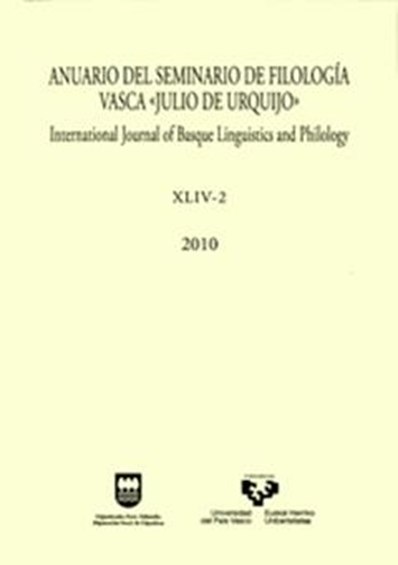Re-deconstruyendo la balada: «Atharratze jauregian»
##plugins.themes.bootstrap3.article.main##
##plugins.themes.bootstrap3.article.sidebar##
Abstract
The narrative ballad «Atharratze jauregian» («La fiancé de Tardets», «La palaciana de Tardets») is known via several versions collected from the oral tradition throughout a century (1847-1947). It is one of the most outstanding «Ballad-Types» of the Basque corpus, but also one of the most problematic ones. This article proposes a method to analyse its central subject and its variations, both formal and of content, that have developed in the course of its oral transmission. Starting from the complete corpus of versions that is currently known, the article differentiates the valid testimonies from the useless, as redundant or partially uncertain ones due to textual manipulations of different degrees.
With no aim at a textual 'reconstruction' of the ballad's archetype, the article advances the thesis that its origin does not lie in a historical fact of the end of the 16th century, i. e. the marriage between Charles de Luxe and Marie d'Ossès in 1587 and the couple's subsequent exile to Navarre due to its opposition to the Protestant Reformation by Jeanne d'Albret, (J. Jaurgain), nor in a medieval ballad that in its subsequent evolution would have converged with that historical fact (J. B. Orpustan). The ballad would rather constitute a reflection, endowed with general validity, about the real conflict of exogamy and the dialectics between uxorilocality and virilocality, subjects that also appear in other ancient ballads of the Basque repertoire, where the conflict is usually sorted out by the wife's death.
Despite the deficiencies of the available corpus, it can be concluded that some particular innovations and developments existed in a central, Low-Navarre area, which are characterized by the personification and novelization of the option contrary to exogamy.
In reality, these innovations only make explicit what was already present in the primitive, Souletin, model of the ballad. The article maintains that the polysemous virtuality of the term 'Sala', which originally designated the main character's native home, and so the sphere of endogamy, achieved later a new sense: that of a concrete, 'domestic' suitor ('Sala of Tardets'), desired by the main character ('Santa Klara'), who is opposed to the exogamous husband ('The King of Hungary'). In the Low-Navarre reinterpretation, a fully individualized 'Sala', that constitutes a third dramatis persona, receives the exiled woman's last message and takes charge of the suicide's corpse. However, even in this innovative, novelized model, other reading possibilities still remain latent, closer to the primary, original sense, as postulated here, of the ballad.
Along a proposition of sequential division of the story, the article analyses the details of the most significant variants in the corpus of the versions. The variation mechanisms constitute punctual lexical alternations, amplifications of motives and scenes, or «corruptions» by other ballad subjects («Andre Milia», «Ursua») and probably by independent lyrical short folk songs resemanticized in the context of the ballad. But it is argued that
the most important alterations arise from the different realignments caused by the move of some stanzas from some sequences to others. The article includes the edition of the global corpus of the complete primary versions, made of the most reliable, or unique hand-written and printed textual testimonies at our disposal.
How to Cite
##plugins.themes.bootstrap3.article.details##
This works is licensed under a Creative Commons Attribution-NonCommercial-NoDerivatives 4.0 International License.


